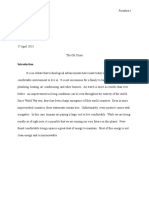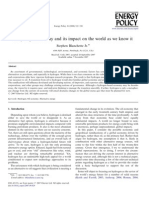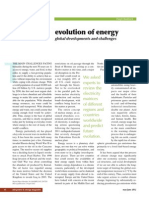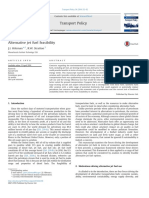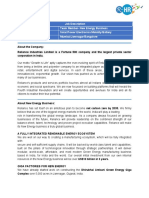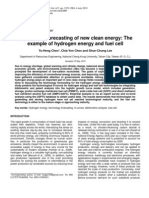13867756-Totten-Renewables-Chapter-in-a-Climate-for-Life-08
13867756-Totten-Renewables-Chapter-in-a-Climate-for-Life-08
Uploaded by
Kal JCopyright:
Available Formats
13867756-Totten-Renewables-Chapter-in-a-Climate-for-Life-08
13867756-Totten-Renewables-Chapter-in-a-Climate-for-Life-08
Uploaded by
Kal JCopyright
Available Formats
Share this document
Did you find this document useful?
Is this content inappropriate?
Copyright:
Available Formats
13867756-Totten-Renewables-Chapter-in-a-Climate-for-Life-08
13867756-Totten-Renewables-Chapter-in-a-Climate-for-Life-08
Uploaded by
Kal JCopyright:
Available Formats
See discussions, stats, and author profiles for this publication at: https://www.researchgate.
net/publication/259219445
Renewable Energy
Chapter · January 2008
CITATIONS READS
0 3,737
1 author:
Michael P. Totten
AssetsforLife.net
38 PUBLICATIONS 150 CITATIONS
SEE PROFILE
All content following this page was uploaded by Michael P. Totten on 02 June 2014.
The user has requested enhancement of the downloaded file.
CHAPTER TWO
Renewable Energy
Michael Totten
or millennia, renewable energy from the wind, sea, sun, and land
F provided all of the Earth’s energy needs. It was the Industrial Era
that drove humanity to use coal, oil, and natural gas fossil fuels (and
eventually nuclear energy) to support its nearly insatiable appetite for power.
Today we face energy and climate crises that threaten both the survival of the
human species as well as biodiversity across the globe. In response, renewables
are once again being pursued as one of the key solutions to meet our needs
in a sustainable way. This chapter focuses on what they actually are and what
they can contribute.
World consumption of fossil fuels has increased exponentially in the past
century, and industrialized countries consume the lion’s share. In 2005, China
consumed as much coal as the United States, Russia, India, and Australia
combined. However, the United States, with only 5% of the world’s population,
consumes one-fourth of the daily global oil supply, whereas China accounts
for 6% of consumption with one-fifth of global population. Between 2000
and 2025, oil use is officially forecast to grow by 44% in the United States and
57% in the world. By 2025, the United States will use as much oil as Canada,
Western and Eastern Europe, Japan, Australia, and New Zealand combined.
The forecasted increase alone in U.S. oil imports will exceed the 2001 total oil
use of China, India, and South Korea (Lovins et al., 2004).
Yet the problems of growth are not limited to the United States. Today, only
12% of the world’s population own cars. Africa and China currently have the
car ownership America enjoyed in 1915. However, China’s compound annual
car growth was 55% between 2001 and 2005. By 2025, its cars could require
the oil output of a Saudi Arabia or two (which now exports one-fourth of
world oil).
Such harrowing growth rates in fossil fuel usage will dramatically increase
greenhouse gas emissions to a level threatening to derail society’s capacity to
stabilize atmospheric concentrations below a safe threshold, triggering multi-
century catastrophic consequences (Hansen, 2005; Hansen et al., 2008;
An early-morning wave breaks into the sunrise in Ventura, Romm, 2007). Fortunately, a significant fraction of the growth rate in the
California. There are many ways to tap the energy available
global demand for energy and mobility services can be effectively satisfied
in the ocean, including harnessing underwater currents, tidal
flows, and wave motion. TODD GLASER through smart energy efficiency improvements, at tens of trillions of dollars
77
Climate4Life.indb 77 6/27/08 7:44:09 PM
A CLIMATE FOR LIFE
Livestock release methane, and research is showing how to
reduce it. At the same time, methane from animal waste can
be recycled into a renewable gas. PETER ESSICK
lower cost this century compared to conventional supply expansion. Moreover, Opinion surveys consistently show that more than 80% of citizens prefer
as illuminated in Chapter 1: Energy Efficiency, many of the efficiency gains solar and other renewables and energy efficiency to the use of fossil fuels. This
actually enhance the cost-effectiveness of wind and solar energy options. is not surprising, given the unimaginably vast amount of renewable energy
Renewable resources take diverse forms and include solar, wind, geothermal, flows worldwide. Consider that global human energy consumption in 2007
biological, and hydrological sources. They can be used to provide any of the amounted to just one hour of sunlight landing on Earth. Expert evaluations
myriad applications for which humankind requires: thermal heat; solid, liquid, conclude that renewables are quite capable over the long term, in combination
or gaseous chemical fuels; or even electricity. with extensive energy efficiency gains, to economically provide the current
Many of these sources are highly cost-effective now and will only become total global energy supply many times over.
increasingly economical in the coming decades. To facilitate their application
and acceptance, we need to stop providing incentives for outdated and Solar. Solar technical potential is conservatively estimated at greater than 50
unsustainable fuel technologies and focus instead on the most ecologically terawatt-years per year, or more than three times the current annual global
sustainable renewable sources, notably wind and solar. The combination, in energy use. From 2000 to 2100, solar’s technical potential of 5,000 terawatt-
particular, of vehicle-to-grid system efficiencies and expansion of wind and years is 277% greater than the remaining post-efficiency supply requirements
solar energy offers multiple benefits: reduced cost of energy services; dramatic (i.e., after harnessing the large pool of cost-effective energy-efficiency
reductions in greenhouse gases, acid rain, and urban air pollutants; deep opportunities). This solar technical potential was characterized nearly a decade
reductions in oil imports; and significantly less wilderness habitat converted ago, and faster market developments indicate this potential will increase over
and fresh water diverted to grow fuel crops. time as continuous scientific advancements and technological breakthroughs
It will also take ambitious research, development, and demonstration are able to capture an ever-larger fraction of the theoretical potential of
initiatives, coupled with market-based incentives and innovative regulatory 124,000 terawatt-years, or nearly 4 million exajoules per year.
policies, to ensure the timely availability of economically attractive and
affordable renewables on a global scale throughout this century. Wind. Wind technical potential is more than 20 terawatt-years per year, or
more than 134% of the current annual global energy use. From 2000 to 2100,
Abundant Options wind’s technical potential of 2,000 terawatt-years is more than 110% greater
Current global energy consumption is about 15 terawatt-years or 475 exajoules, than the remaining (post-efficiency) supply requirements. About 1–2% of the
the equivalent of oil supertanker shipments arriving at the rate of one every energy coming from the sun is converted into wind energy. Wind’s theoretical
ten minutes, or the distribution of fuel to service stations by 437 million potential is 2,476 terawatt-years, or 78,000 exajoules per year.
delivery trucks per year. Projected energy consumption worldwide from 2000
to 2100, assuming no change in human behavior, is approximately 240 times Geothermal. Geothermal technical potential is about 160 terawatt-years per
the current amount—about 3,600 terawatt-years or 113,000 exajoules. Fossil year, or more than ten times the current annual global energy use. The Earth’s
fuels, also assuming no change in human behavior, would account for three- interior reaches temperatures greater than 4,000°C, and this geothermal energy
fourths of this sum, releasing several trillion tons of greenhouse gases, while flows continuously to the surface. From 2000 to 2100, geothermal’s technical
tripling the Earth’s atmospheric concentration of greenhouse gases (in carbon- potential of 16,000 terawatt-years is 900% greater than the remaining (post-
dioxide equivalents) from pre-industrial levels. efficiency) supply requirements. Geothermal’s theoretical potential worldwide
78
Climate4Life.indb 78 6/27/08 7:44:09 PM
RENEWABLES
differences between different layers of the ocean
(called Ocean Thermal Energy Conversion). More
research remains to be done on the ecological
impacts of the options on marine life, and these
technologies may play a niche role for some island
and coastal communities.
Hydropower. Hydropower’s technical potential is
1.6 terawatt-years per year, or a bit over 10% of
current annual global energy use. From 2000 to
2100, hydro’s technical potential of 160 terawatt-
years is 9% of the remaining (post-efficiency)
is 440,000 terawatt-years, or 14 million exajoules per year. Domestic resources supply requirements. This potential is further limited by serious ecological,
in the United States are equivalent to a 30,000-year energy supply at the social, and climatic problems associated with some river sites.
current rate of consumption.
Counting the Costs
Biomass. Biomass technical potential is 8.6 terawatt-years per year, or 57% of Not surprisingly, much of the lively and contentious debate over future
current annual global energy use. From 2000 to 2100, biomass’s technical energy supplies tends to reduce itself to one key criterion: cost. This is myopic
potential of 860 terawatt-years is 48% of the remaining (post-efficiency) for two reasons. First, assumptions about long-term technological cost and
supply requirements. On average, plant net primary production (NPP) is performance data inherently contain a fair degree of subjective judgment. The
about 5 million calories per square meter per year. An important caveat about future is uncertain in too many ways, precluding any technical assessment to
biomass availability is that global NPP is the amount of energy available to claim complete objectivity or certitude. Moreover, current views on technology
all subsequent links in critical ecosystem services plus the food, fiber, animal options are heavily conditioned by the long trail of public interventions and
feed, and biofuel chain. The Earth’s surface area is about 500 trillion m2. The subventions shaping markets and investment patterns. For humanity to avoid
net power output stored by plants is thus 19 terawatt-years, or 0.01% (1/100th catastrophic climate change, and avert conflicts and wars over oil resources,
of 1%) of the sun’s power emitted to Earth. there will need to be a dramatic change in the calculus of energy policy-
making and investment decision-making. This means it is a wide-open arena
Oceans. Ocean power’s technical potential (more than 80% from thermal for all energy options, even the current energy giants, since the accumulated
energy conversion) is 5 terawatt-years per year, or one-third of current annual rules and subsidies currently in place are now facing a radical makeover to
global energy use. From 2000 to 2100, the ocean’s technical potential of 500 align outcomes for climate-positive, real energy-security results (DeCanio,
terawatt-years is 27% of the remaining (post-efficiency) supply requirements. 2003; Smil, 2003).
There are various potential ocean technologies, such as harnessing the power of Second, cost and climate emissions are just two criteria among many for
underwater currents, tidal flows, wave motion, and exploiting the temperature ensuring a sustainable smart-energy system worldwide this century. There
79
Climate4Life.indb 79 6/27/08 7:44:15 PM
A CLIMATE FOR LIFE
The cooling towers of a nuclear power plant frame a
traditional windmill in St. Laurent des Eaux in France’s Loire
Valley. Contemporary wind turbines, designed with state-
of-the-art technologies, now deliver electricity at several
times lower cost than nuclear power. THOMAS HOEPKER
is a rich literature developed in the wake of innumerable energy crises over some intractable or intrinsic to the energy option, that have been costly to
the past forty years stressing important attributes that should be sought in human well-being and ecological health.
energy services to achieve a high probability of avoiding adverse impacts and For example, hydroelectric power is promoted as the most cost-effective
unintended consequences (Lovins and Lovins, 1982; Lovins et al., 2004; Smil, renewable energy solution for climate change. This is grossly misleading and
2003). A dozen criteria recur as important attributes of energy supplies: highly inaccurate. Actual measurements of hydrodams in different parts of
the world indicate they are responsible for an estimated 8% of total global
• Is it economically affordable, even for the poorest of the poor
greenhouse gas emissions, and projected expansion in coming decades, mostly
and cash-strapped?
in wilderness areas, could increase this to 15% of total emissions (St. Louis
• Is it safe through its entire life cycle?
et al., 2000). Hydrodams have also been the major reason why one-fourth of
• Is it clean through its entire lifespan?
freshwater species have been driven to extinction worldwide (Bräutigam, 1999)
• Is its risk low and manageable during financial and price volatility?
This is not to say that all hydro facilities release greenhouse gas emissions. Not
• Is it resilient and flexible to volatility, surprises, miscalculations,
all hydroelectric plants require dams, and not all dams generate electricity.
and human error?
And clearly other extenuating circumstances come into play (e.g., the need for
• Is it ecologically sustainable, with no adverse impacts on
irrigation) (WCD, 2000).
biodiversity?
This reinforces the point that using multiple criteria to prioritize preferable
• Is it environmentally benign in that it maintains air, water, and
energy options this century, coupled with the alignment of public policies
soil quality?
and regulations towards this end, is imperative given the looming threat of
• Will it fail gracefully, not catastrophically, in response to abrupt
climate catastrophe in need of fast and massive action, while at the same
surprises or crises?
time avoiding wars and conflicts over the accelerating demand for vulnerable
• Will it rebound easily and swiftly from failures, with low recovery
oil supplies; avoiding and reversing the contamination of air, water, and soil;
cost and limited lost time?
avoiding nuclear weapons proliferation; and preventing the destruction of
• Does it have endogenous learning capacity, with intrinsic new
wildlife and biodiversity loss.
productivity opportunities?
In addition, we must now take into account the increasing occurrence of
• Does it have a robust experience curve for reducing negative
climate-triggered mega-droughts, super-hurricanes, deluge-level floods, larger
externalities and amplifying positive externalities,
and longer wildfires, more widespread pest devastation, and the adverse
including scalable innovation possibilities?
impacts these will have on energy installations. It is also prudent in a post-
• Is it an uninteresting target for malicious disruption,
9/11 world—where nuclear reactors and large refineries now remain on
off the radar of terrorists and military planners?
constant alert to possible terrorist attacks—to design energy systems that are
Among the range of available energy options, only energy services from uninteresting targets (Romm, 2007).
efficiency gains rank at the top in every attribute. All other options are
deficient or weak in two or more of these attributes. The vast expansion of Proper Investment and the Future of Renewables
energy consumption from coal, oil, natural gas, nuclear, hydrodams, and In spite of renewables’ overwhelming potential, existing public policies—as well
wood and crops over the past century has revealed a series of grave problems, as the majority of future-looking global energy assessments—reflect negligible
80
Climate4Life.indb 80 6/27/08 7:44:16 PM
RENEWABLES
Moreover, nuclear power continues to receive
unprecedented taxpayer-subsidized insurance
coverage for reactor disasters. A similar taxpayer
burden is now being proposed to underwrite
federally assumed liability of a century-long
leakage risk from carbon capture and storage
projects. Likewise, the fossil fuel industries have
received considerable largesse and investment
stability as a result of long-standing subsidies,
while emerging competitive options like wind
power suffer financial instability because the
Production Tax Credit is sunset every few years,
roles for solar, wind, and geothermal energy sources or the ambitious efficiency wreaking havoc by disrupting investment flows (Koplow and Dernbach,
gains posited in Chapter 1. On the contrary, they emphasize massive fossil 2001).
fuel carbon capture and storage (CCS) operations, aggressive nuclear power In sharp contrast, however, is the attention that many other nations, as
expansion, enormous biomass plantations, and large-scale hydro development well as a number of U.S. states, have focused on the future of renewables to
(Hamrin, Hummel, and Canapa, 2007). This is due less to technical or meet the range of environmental, economic, social, and security criteria noted
economic constraints than to institutional and political inertia. above. There is a growing body of literature describing that future, including
Over the past half century, governments have provided (and continue to policy targets and shifts in financial incentives based on insights gleaned
provide) several trillion dollars per decade in subsidies—nearly two-thirds from socio-economic and technology scenarios, carbon-constrained scenarios,
have been dedicated to fossil fuels (mostly to coal and oil) and one-fourth and future social visions. Policy targets for future shares of renewable energy
to nuclear power. Only 5% went to all non-hydro renewables (solar thermal, are described for regions, specific countries, states/provinces, and cities. By
solar-electric photovoltaics, solar-thermal-electric “concentrated solar power” 2020, many targets and scenarios show a 20–35% share of electricity from
systems, terrestrial wind, offshore wind farms, geothermal heat, geothermal- renewables, increasing to 50–80% by 2050 under the highest scenarios
electric) and all efficiency (buildings, transportation, appliances, industry, (Martinot et al., 2007).
combined heat and power). For each U.S. tax dollar supporting wind power or Two scenarios with very ambitious efficiency and renewable goals were
solar power research and development over the past fifty years, nuclear power released in 2007 by the European Renewable Energy Commission (EREC,
received 100 times more. Even in the U.S. 2008 federal appropriations, wind 2007) and by the American Solar Energy Society (ASES, 2007), the latter
power research and development funding was $40 million vs. $400 million limited to the United States. The European Renewable Energy Commission
for nuclear. This makes no sense given the fact that wind power generates projects 70% renewables in the electric sector (while constraining nuclear
electricity already competitive to nuclear reactors and has a global technical and large hydro), and the American Solar Energy Society forecasts 50%
potential that could provide twice the level of total global energy needs this renewables in the U.S. electricity sector by 2030 (also ignoring nuclear and
century (in combination with ambitious efficiency gains) (GWEC, 2006). large hydro). The high penetration rates are directly due to the fact that both
81
Climate4Life.indb 81 6/27/08 7:44:17 PM
A CLIMATE FOR LIFE
An electric Smart Car advertises the New York City Marathon
in Midtown Manhattan’s Times Square. Using plug-in hybrid
technology, the electricity infrastructure in the United States
could potentially power the daily use of 84% of the nation’s
cars, pickup trucks, and SUVs. CHUCK PEFLEY
reports estimate half or more of total energy supply being displaced through use these complementary strengths, and to reconcile the complementary needs
lower-cost energy-efficiency gains—by a factor of four to one in the case of of the driver and grid manager” (Kempton and Tomić, 2005).
the EREC projects. As discussed in the chapter on efficiency and smart energy services, the
The ASES report is highly transparent and richly detailed and strongly existing U.S. grid could recharge 80% of America’s 200+ million vehicle fleet
demonstrates that energy efficiency and renewable energy technologies if they were plug-in hybrid electric vehicles, without having to build a new
have the potential to provide most, if not all, of the U.S. carbon emissions power plant. This would have the positive effect of eliminating 52% of U.S.
reductions that will be needed to help stabilize the atmospheric concentration oil imports (340 billion liters per year) worth some $350 billion savings at the
of greenhouse gases (Hamrin, Hummel, and Canapa, 2007). However, while gas pump, while also reducing total U.S. carbon dioxide emissions by 27%
some renewable options accrue multiple benefits and positive externalities (PNNL, 2007).
and should be encouraged, other renewable options trigger adverse impacts or As with the market diffusion rate of any major technological innovation
incur negative tradeoffs. This is especially the case when a supply option like (accelerated to some degree by favorable public policies and incentives),
biofuels is vastly expanded over space and time. declining manufacturing costs and vehicle prices will occur with accumulated
High oil prices have driven policymakers to set high production targets experience of scaled-up production. Researchers note another tremendous
and enact lavish subsidies for investors to develop biofuels from agricultural benefit of vehicle-to-grid over time, as production costs drop: providing
crops. Mobile liquid biofuels—both ethanol derived from corn and sugarcane battery storage for intermittent wind power and solar electricity generation.
and biodiesel derived from oil palm, soybean, and rapeseed—are not only Research calculations suggest that vehicle-to-grid could stabilize large-scale
more expensive than vehicle efficiency gains by a factor of two to five (Lovins (one-half of U.S. electricity) wind power with 3% of the fleet dedicated to
et al., 2004), but also more expensive than system efficiency gains achievable regulation for wind, plus 8% to 38% of the fleet providing operating reserves
by connecting plug-in hybrid electric vehicles to the national electricity grid or storage for wind (Kempton and Tomić, 2005). For context, currently half
system. Genetically modified fuels of the future are likely to lower production of U.S. electricity is coal-fired.
costs, but pose many of the same ecological issues associated with current The vehicle-to-grid technological revolution is driven by many of the same
biofuels (Jacobson, 2007). digital electronics and advanced materials that enable production and operation
of high-efficiency, lower energy-consuming smart appliances, smart grids,
Preeminent Solutions: Electric Vehicles smart buildings, and smart cars. It offers an economic development strategy
Research and developments over the past two decades in the production of for developed and developing countries alike. With the majority of the world’s
electric vehicles and separately in the commercialization of hybrid-electric population becoming urban-based, electric and hybrid-electric vehicles can
vehicles have given rise to the recognition that plugging vehicles into the grid accommodate the typical urban driving cycles of 16 to 48 kilometers per day.
system would accrue several remarkable benefits far superior to continuing to Longer distances can be provided by the flexible fuel component derived from
run vehicles entirely on mobile liquid fuels. As researchers have pointed out, local and regional biowastes.
“The vehicle fleet has twenty times the power capacity, less than one-tenth the
utilization, and one-tenth the capital cost per prime mover kilowatt. Conversely, The Role of Biofuels
utility generators have ten to fifty times longer an operating life and lower Local and regional biowastes can be converted to biofuels, providing the
operating costs per kilowatt-hour. To tap Vehicle-to-Grid is to synergistically mobile fuels essential for long-range driving beyond electric battery capacity.
82
Climate4Life.indb 82 6/27/08 7:44:17 PM
RENEWABLES
renewable resources; accumulated scientific
knowledge also gives good indication they will
incur the smallest climate and ecological footprints
when scaled up globally and operated over long
time periods. Solar photovoltaics and wind power
have the added advantage of requiring 95% less
water per terawatt-year than coal or nuclear power,
biopower or solar-thermal-electric “concentrated
solar power” (CSP) systems.
In a vehicle-to-grid connected world, with
solar and wind power stored in the mass
distribution of plug-in hybrid electric batteries,
Such a modest use of biofuels would prevent some of the near-intractable sixty and thirty times less land area, respectively, would be needed than in
problems associated with large-scale biofuel consumption. the case of biofuels for the same power output (Jacobson, 2007). Roughly
Unfortunately, one unintended negative consequence of corn-based 7% of the U.S.’s 50 million hectares of urban land area covered with solar
ethanol expansion in the United States is that it drives soy production to photovoltaic panels at today’s 10%-efficient systems could provide 100% of
Brazil and Argentina (where it is grown mainly for animal feed), which leads U.S. electricity. Brownfields could provide most of the land area. Building-
to deforestation and destruction of biodiversity-rich savannah grasslands integrated photovoltaic systems (BIPVs) could provide half of the power
and Amazon ecosystems (CARD, 2007; Searchinger et al., 2008; Fargione et (Kazmerski, 2002; Zweibel, 2004). Alternatively, around 2.5% of the North
al., 2008). Similarly, oil palm plantations in tropical countries, already one American Great Plains with dispersed wind farms—or roughly 92 million
of the major causes of biodiversity loss, are the preferred low-cost feedstock out of 363 million hectares—could provide 100% of U.S. electricity. The
for biodiesel. Some of the last remaining intact wilderness habitats for actual footprint of the several hundred thousand multi-megawatt turbines,
mega-charismatic species like the orangutan and the Sumatran tiger, and hypothetically squeezed into one spot, would be less than the size of one large
also rhino and elephant are threatened with conversion to oil palm. Species Wyoming coal strip mine (Komanoff, 2006; Williams, 2001). Even when
extinction will be the outcome of people “putting an orangutan in your spaced out to optimize wind capture, 90% of the 2.5% could still be farmed,
tank.” ranched, or ecologically restored.
Minimizing biofuel expansion reduces the adverse impacts on ecosystems Several valuable benefits would accrue to rural communities from such
and biodiversity loss in tropical countries already being caused by ethanol and a strategy. Farmers and ranchers can earn, on average, twice as much from
biodiesel plantation growth (Morton et al., 2006; Fearnside, 2002; Killeen, wind farm royalty payments than they currently obtain from crop and
2007). It also avoids driving up food prices (CARD, 2007). animal farming. Currently 75% of the Great Plains is farmed or ranched,
but only generates 5% of the region’s economic output. Shifting to wind
Harnessing the Sun and the Wind farming could produce twice as much economic output on thirty-five times
Solar, wind, and geothermal energy systems are not only the three largest less land area. Similarly, vast wind resources are available in China and
83
Climate4Life.indb 83 6/27/08 7:44:18 PM
A CLIMATE FOR LIFE
The people of Hveragerdi, in southwest Iceland, use
geothermal energy to heat their greenhouses. Geothermal
heat in Iceland is also used for swimming pools, to bake
bread, and to heat up footpaths, streets, and parking spaces.
ARCTIC-IMAGES/CORBIS
India, as well as along coastal regions throughout the world (Totten, 2007; megawatts of combined heat and power could be online in several years if a
GWEC, 2006; NREL, 2006). China and India will account for 80% of number of important power sector reforms occur (WADE, 2004).
coal increase by 2030. China annually expands its coal use equivalent to For nations like China facing water crises, combined heat and power offers
that of the United Kingdom. It surpassed the United States in 2007 as a highly cost-effective system efficiency option for combining the delivery of
the world’s top greenhouse gas emitter. However, China’s wind technical energy and potable water. Water consumes considerable energy throughout
potential is estimated at 2 million megawatts, 400% larger than China’s the process of extracting, pumping, distributing, heating, and disposing.
total electric generation capacity. In addition, twice as much solar energy In California, for example, 20% of the electricity and one-third of natural
lands on China each year than could be produced from its 800 billion tons gas are consumed by the water sector (NRDC and Pacific Institute, 2004).
of coal over the next several centuries. Delivering water services efficiently saves money, reduces air pollution, and
cuts greenhouse gases. China faces the additional problem that its water
Economies of Efficiency—Combining Heat and Power resources per capita may decline to around 1,700 cubic meters by 2050, which
Instead of targeting massive investments into central, large-scale, coal, nuclear, is the threshold of severe water scarcity. Water shortage already has become a
and hydroelectric generating stations, cities around the world should be critical constraint for socio-economic development in northern China, where
looking for energy system efficiencies that could enable phasing in use of local per capita levels are now below 300 cubic meters. To solve or eliminate water
and regional biological wastes over the long-term. One of the proven options shortage problems, China is now pursuing all water-efficiency opportunities
available globally is decentralized combined heat and power. Whereas central (e.g., drip irrigation) that can cut water use by two-thirds on farms (which
thermal power plants vent 70% of the energy when generating electricity, consume 80% of all water).
combined heat and power systems capture this waste heat to cogenerate
two, three, or four different energy services (heat, steam, electricity, cooling). Alternative Water Supplies
Moreover, in being sited close to the point of use, combined heat and power Meanwhile, wastewater and seawater desalination are drawing more and
systems require significantly less transmission and distribution investment more attention from researchers and policy-makers as alternative water supply
than centralized power plants, as well as avoiding the 15% transmission and sources (Zhou and Tol, 2003).
distribution line losses (WADE, 2004). For example, just the waste heat Desalination costs currently vary by a factor of seven or more, depending on
discarded from U.S. power plants is equivalent to 1.2 times Japan’s total the type of feedwater (brackish, waste, or seawater), the available concentrate
energy use. disposal options, the proximity to distribution systems, and the availability
Recent assessments indicate that if China moved to 100% high-efficiency and cost of power. Desalination’s primary operating cost is for power. One
decentralized combined heat and power systems by 2021, retail and capital cubic kilometer (one trillion liters) of wastewater or seawater desalination
cost savings could reach $400 billion. At no extra cost, new emissions of requires about 500 megawatts of power. The reduction in unit energy use by
carbon dioxide would drop 56%, avoiding 400 million tons of such emissions desalination plants has been among the most dramatic improvements in recent
per year, and nitrogen oxide and sulfur dioxide emissions would decline by years due to improvement in energy recovery systems. Estimates considered
90%. But these results are possible only if the Chinese government adopts valid for China today range from a cost of $0.60 per cubic meter (1,000 liters)
key policies enabling a faster rate of implementation than the current annual for brackish and wastewater desalination to $1 per cubic meter for seawater
combined heat and power addition of 3,000 megawatts. Some 100,000 desalination by reverse osmosis (Zhi, Totten, and Chou, 2006).
84
Climate4Life.indb 84 6/27/08 7:44:18 PM
RENEWABLES
operate reverse osmosis technologies to purify
these wastewaters, while also providing ancillary
energy services like space and water heating and
cooling.
The Final Hope
As the chapter on efficiency and smart energy
services describes, ensuring the capture of the
immense pool of efficiency opportunities could
deliver more than half of the world’s cumulative
energy services at lower cost and risk than
expanding energy supplies, replacing the need
Extrapolating from technological trends, and given the promise of for 1,800 terawatt-years or 57,000 exajoules of energy supplies. Envision
ongoing innovations in lower-cost, higher-performance membranes, seawater eliminating the need for 13.8 billion coal railcars this century. However, that
desalination costs will continue to fall. The average cost may decline to still leaves a demand for another 1,800 terawatt-years or 57,000 exajoules of
$0.30 per cubic meter in 2025. For comparison, China’s average (subsidized) energy supply. A lively debate has ensued as to the best options for satisfying
water prices are $0.25 per cubic meter for domestic and industrial use, $0.34 this immense growth.
per cubic meter for commercial use, $0.60 per cubic meter in Tianjin and Smarter delivery of energy services through efficiency gains can effectively
Dalian, and approaching $0.80 per cubic meter at full pricing in cities like satisfy most of this growth, while saving money and reducing emissions
Beijing. provide ancillary benefits. Combining these with steady increases in harnessing
Desalination of wastewater via combined heat and power can capture energy services powered by wind, solar, geothermal, and biowastes promises
double benefits: it reduces contaminated discharges into rivers and, instead, society a long-term, clean, safe, secure, and ecologically sound energy system.
expands the city’s freshwater supplies at lower cost than importing remote water Achieving this ambitious but feasible outcome is fundamental for resolving
resources. The Reverse Osmosis membrane process is universally considered climate and energy crises, while bringing all of humanity to health and
to be the most promising technology for brackish and seawater desalination well-being and preventing the unnecessary extinction of the planet’s rich
A model of using reverse osmosis membranes powered by combined heat and biodiversity of plants and animals.
power is the Ashkelon plant in Israel, which produces 100 million cubic meters
per year of potable water at a highly cost-effective 50 cents per cubic meter.
China’s total wastewater discharges annually exceed 60 cubic kilometers (60
trillion liters). As of the late 1990s, less than one-seventh of this wastewater
was treated. Close to 600 million Chinese people have water supplies that are
contaminated by animal and human waste. Harnessing 30,000 megawatts
of co-generation available in cities and industrial facilities potentially could
85
Climate4Life.indb 85 6/27/08 7:44:18 PM
View publication stats
You might also like
- Rays of Hope Transition To A Post Petroleum WorldDocument232 pagesRays of Hope Transition To A Post Petroleum WorldplutocowNo ratings yet
- The Future of Hydrogen-Opportunities and Challenge PDFDocument14 pagesThe Future of Hydrogen-Opportunities and Challenge PDFDavid Fernando Otalvaro ZuletaNo ratings yet
- Architecture&design Bahrain WTCDocument7 pagesArchitecture&design Bahrain WTCKashif AfridiNo ratings yet
- Encyclopedia of Agricultural Food and Biological EngineeringDocument16 pagesEncyclopedia of Agricultural Food and Biological Engineeringa4agarwalNo ratings yet
- Unit-1fundamentals of EnergyDocument185 pagesUnit-1fundamentals of Energy010 Monitha SaiNo ratings yet
- A. Energy: An Initial Definition: ConsiderationsDocument34 pagesA. Energy: An Initial Definition: ConsiderationsJames WoleNo ratings yet
- Week 3 Lecture NotesDocument35 pagesWeek 3 Lecture NotesMikeNo ratings yet
- Chapter 1 Non Conventional Energy Sources by GD Rai - pdf.5UdpWQhnfLP29KdfrwnxHkuCmhtb3pMtDocument33 pagesChapter 1 Non Conventional Energy Sources by GD Rai - pdf.5UdpWQhnfLP29KdfrwnxHkuCmhtb3pMtritikshariya47No ratings yet
- 1 Running Head: Environmentally Wise and Globally Peaceful AlternativesDocument17 pages1 Running Head: Environmentally Wise and Globally Peaceful AlternativesrjbrowneiiiNo ratings yet
- Essay On Global Energy CrisisDocument5 pagesEssay On Global Energy CrisisMuhammad Hafeez0% (1)
- 31 August 6 Sep 2019Document48 pages31 August 6 Sep 2019M KumarNo ratings yet
- Dr. Pramod, DDUC Energy Resources Book ChapterDocument21 pagesDr. Pramod, DDUC Energy Resources Book ChapterAVIRAL PRATAP SINGH CHAWDANo ratings yet
- Issue Brief Final Copy Joseph ForadoraDocument13 pagesIssue Brief Final Copy Joseph Foradoraapi-665611707No ratings yet
- Biofuels From Algae Challenges and PotentialDocument35 pagesBiofuels From Algae Challenges and PotentialWendy Tie Kai SingNo ratings yet
- The Energy Innovation ImperativeDocument21 pagesThe Energy Innovation ImperativeTheHiddenSoldiersNo ratings yet
- Energy Resource EngDocument14 pagesEnergy Resource EngAakash SharmaNo ratings yet
- Global Energy CrisisDocument4 pagesGlobal Energy Crisisnazarmudassar511No ratings yet
- Energy and Air PollutionDocument43 pagesEnergy and Air PollutionBimo S WicaksonoNo ratings yet
- Ethics + PolicyDocument3 pagesEthics + Policystanscimag100% (2)
- Welcomes: Graduate Trainees in Power Systems Training InstituteDocument36 pagesWelcomes: Graduate Trainees in Power Systems Training Institutegaurang1111No ratings yet
- Energy Resources: Earth ScienceDocument22 pagesEnergy Resources: Earth ScienceRegina Mae Narciso NazarenoNo ratings yet
- Solar Energy: A Viable Pathway Towards Ecologically Sustainable DevelopmentDocument4 pagesSolar Energy: A Viable Pathway Towards Ecologically Sustainable DevelopmentYashkalp SharmaNo ratings yet
- Rays of Hope Transition To A Post Petroleum WorldDocument232 pagesRays of Hope Transition To A Post Petroleum WorldplutocowNo ratings yet
- Resources, Energy and DevelopmentDocument7 pagesResources, Energy and DevelopmentAlexandros FilippouNo ratings yet
- Hydrogen Economy and Impact March 22 Last MeetingDocument9 pagesHydrogen Economy and Impact March 22 Last MeetinghmationgNo ratings yet
- The Future of Hydrogen - Opportunities and Challenges: Michael Ball, Martin WietschelDocument13 pagesThe Future of Hydrogen - Opportunities and Challenges: Michael Ball, Martin WietschelIshan PatilNo ratings yet
- Acting in Time On Energy PolicyDocument12 pagesActing in Time On Energy PolicyPanait AndreiNo ratings yet
- Sustainable Energy For AllDocument35 pagesSustainable Energy For AllDan GoodmanNo ratings yet
- Energy SecurityDocument21 pagesEnergy Securityluz fernandezNo ratings yet
- Week 1 NotesDocument16 pagesWeek 1 NotesSubra Pratik RoutNo ratings yet
- Final Year ProjectDocument56 pagesFinal Year ProjectBiniam SolomonNo ratings yet
- ENERGY-CRISIS-GRP-13.pdf 20240425 154756 0000Document37 pagesENERGY-CRISIS-GRP-13.pdf 20240425 154756 0000cherry may castilNo ratings yet
- Renewable Energy SourcesDocument10 pagesRenewable Energy SourcesS Bharadwaj ReddyNo ratings yet
- Jack Oughton - Layman's Guide To Nuclear Fusion V1Document72 pagesJack Oughton - Layman's Guide To Nuclear Fusion V1Jack Oughton67% (3)
- Energy Return On Investment, Peak Oil, and The End of Economic Growth (Murphy, & Hall, 2011)Document21 pagesEnergy Return On Investment, Peak Oil, and The End of Economic Growth (Murphy, & Hall, 2011)CliffhangerNo ratings yet
- The False Promise of BiofuelsDocument35 pagesThe False Promise of BiofuelsAndrej BašićNo ratings yet
- Prospects For Making Biofuel From Microalgae A ReviewDocument7 pagesProspects For Making Biofuel From Microalgae A ReviewResearch ParkNo ratings yet
- Articles On Energy CrisisDocument1 pageArticles On Energy CrisisShivam DuttaNo ratings yet
- The Economic Competitiveness of Renewable Energy: Pathways to 100% Global CoverageFrom EverandThe Economic Competitiveness of Renewable Energy: Pathways to 100% Global CoverageNo ratings yet
- Environmental Geography and Sustainable DevelopmentDocument8 pagesEnvironmental Geography and Sustainable DevelopmentAriefz WillNo ratings yet
- Artículo 3Document10 pagesArtículo 3PAULINA SOLIS CORONELNo ratings yet
- S.kale PHD ThesisDocument150 pagesS.kale PHD ThesisArchana RoyNo ratings yet
- Issue Brief Final DraftDocument17 pagesIssue Brief Final Draftapi-664522884No ratings yet
- Final Themenheft IncomindiosDocument48 pagesFinal Themenheft IncomindiosTj RobertsNo ratings yet
- Global Energy Shifts: Fostering Sustainability in a Turbulent AgeFrom EverandGlobal Energy Shifts: Fostering Sustainability in a Turbulent AgeRating: 4 out of 5 stars4/5 (1)
- Article Assessment - Feasibility of Solar EnergyDocument7 pagesArticle Assessment - Feasibility of Solar EnergyManfred AndohNo ratings yet
- Revision GuideDocument89 pagesRevision Guidesteve119100% (1)
- Water Resources Research - 2011 - Wigmosta - National Microalgae Biofuel Production Potential and Resource DemandDocument13 pagesWater Resources Research - 2011 - Wigmosta - National Microalgae Biofuel Production Potential and Resource DemandperhiptanisatuNo ratings yet
- Design and Fabrication of Mini-Air EngineDocument33 pagesDesign and Fabrication of Mini-Air EngineMadhan KumarNo ratings yet
- Sustainable Energy and Resource ManagementDocument318 pagesSustainable Energy and Resource ManagementRajdeepSenNo ratings yet
- 06185747Document5 pages06185747nguyenductuyenNo ratings yet
- 1.ENERGY SCENARIO-merged PDFDocument188 pages1.ENERGY SCENARIO-merged PDFraj walkeNo ratings yet
- Bureau of Energy LiteratureDocument649 pagesBureau of Energy LiteratureRadhakrishnan BalasubramanianNo ratings yet
- Energy Scenario: Syllabus Energy Scenario: Commercial and Non-Commercial Energy, Primary Energy ResourcesDocument158 pagesEnergy Scenario: Syllabus Energy Scenario: Commercial and Non-Commercial Energy, Primary Energy ResourcesJaswant Singh MeenaNo ratings yet
- Review Article: Algae Oil: A Sustainable Renewable Fuel of FutureDocument9 pagesReview Article: Algae Oil: A Sustainable Renewable Fuel of FutureJenny Teves DayritNo ratings yet
- Algae Oil A Sustainable Renewable Fuel of FutureDocument9 pagesAlgae Oil A Sustainable Renewable Fuel of FutureCHROME TVNo ratings yet
- Alternative Jet Fuel FeasibilityDocument11 pagesAlternative Jet Fuel Feasibilitypaulo montoyaNo ratings yet
- Module 1 - Introduction to Solar Energy Development.pptxDocument93 pagesModule 1 - Introduction to Solar Energy Development.pptxchrischan.davefranciscoNo ratings yet
- American Physical Society - September 2008: Energy FutureDocument9 pagesAmerican Physical Society - September 2008: Energy FuturefkcskopjemkNo ratings yet
- Renewable Energy Is Generally Defined As Energy That Comes FromDocument4 pagesRenewable Energy Is Generally Defined As Energy That Comes FromYash ThakkarNo ratings yet
- Comparative Study On Effective Use of Different Types of Energy Resources and Their Role in A Review ReportDocument3 pagesComparative Study On Effective Use of Different Types of Energy Resources and Their Role in A Review ReportJitesh SharmaNo ratings yet
- Kandpal_2022_ECS_Trans._107_8133Document10 pagesKandpal_2022_ECS_Trans._107_8133Kal JNo ratings yet
- Print-ScreenDocument2 pagesPrint-ScreenKal JNo ratings yet
- EDSSCIlatestDocument33 pagesEDSSCIlatestKal JNo ratings yet
- EvaluatingKeyFactorsinWindTurbineEfficiencyDocument7 pagesEvaluatingKeyFactorsinWindTurbineEfficiencyKal JNo ratings yet
- PhysRevApplied.18.064064Document11 pagesPhysRevApplied.18.064064Kal JNo ratings yet
- Annex 2 ECOP For Labor Camp ManagementDocument9 pagesAnnex 2 ECOP For Labor Camp ManagementKal JNo ratings yet
- SIDEL Blower MC SR 2-1 User Manual B&R 2016Document121 pagesSIDEL Blower MC SR 2-1 User Manual B&R 2016Kal J0% (1)
- SIDEL Blower MC PIG SR 2-1 2016 Rev.1Document51 pagesSIDEL Blower MC PIG SR 2-1 2016 Rev.1Kal JNo ratings yet
- PX 55 Flow Component - ValveDocument64 pagesPX 55 Flow Component - ValveKal JNo ratings yet
- SHUBAM Packaging Sachet Machine ManualDocument70 pagesSHUBAM Packaging Sachet Machine ManualKal JNo ratings yet
- SHUBAM Sachet Packaging Machine DF-1301 (Bom-1074) Spare ManualDocument71 pagesSHUBAM Sachet Packaging Machine DF-1301 (Bom-1074) Spare ManualKal JNo ratings yet
- Weekly Facility Reporting TemplateDocument25 pagesWeekly Facility Reporting TemplateKal JNo ratings yet
- Belt Press ManualDocument119 pagesBelt Press ManualKal JNo ratings yet
- Engineering Material and Applications by Engr. JamesDocument97 pagesEngineering Material and Applications by Engr. JamesKal JNo ratings yet
- Project Name: SAMPLE PROJECT 1: Goal: Build A Website For Your CompanyDocument5 pagesProject Name: SAMPLE PROJECT 1: Goal: Build A Website For Your CompanyKal JNo ratings yet
- Rbi Grade B English EssayDocument58 pagesRbi Grade B English EssaythedrealityyNo ratings yet
- Chapter - 2 Justification of The Project From Power AngleDocument33 pagesChapter - 2 Justification of The Project From Power Anglerdina2010No ratings yet
- Final Agenda 062823 USDA Rural Development Puerto RicoDocument2 pagesFinal Agenda 062823 USDA Rural Development Puerto RicoLJL,LLCNo ratings yet
- JD - M.tech and PHD 2023Document3 pagesJD - M.tech and PHD 2023RishabhNo ratings yet
- MKT 4220 Individual AssignmentDocument21 pagesMKT 4220 Individual Assignmenti20018697No ratings yet
- Adoption of Modern Hydrogen Technologies in Rail TransportDocument8 pagesAdoption of Modern Hydrogen Technologies in Rail TransportMahnooshNo ratings yet
- Climate Change in India: Gaps in Policies and PracticesDocument4 pagesClimate Change in India: Gaps in Policies and PracticesIJAR JOURNALNo ratings yet
- Leveraging PSO Algorithms To Achieve Optimal Stand-Alone Microgrid Performance With A Focus On Battery LifetimeDocument7 pagesLeveraging PSO Algorithms To Achieve Optimal Stand-Alone Microgrid Performance With A Focus On Battery LifetimefirdausNo ratings yet
- Environmental Law ReviewerDocument6 pagesEnvironmental Law ReviewerDiegoGalán50% (4)
- Lebanon - Opportunities May.2023Document78 pagesLebanon - Opportunities May.2023Daniel dAzNo ratings yet
- Chen Et AlDocument9 pagesChen Et AlAbhranil GuptaNo ratings yet
- Solar EnergyDocument4 pagesSolar Energyjenn78No ratings yet
- Australian Popular MagazinesDocument8 pagesAustralian Popular MagazinesIelts ReadingsNo ratings yet
- Sts Last Lesson Dec 6Document11 pagesSts Last Lesson Dec 6JAMES ANDREW VELASCONo ratings yet
- The Renewable Energy Law Review - Edition 2Document226 pagesThe Renewable Energy Law Review - Edition 2yuliaNo ratings yet
- Government Drilling For Geothermal Exploration Indonesia - Apriani - 2018Document8 pagesGovernment Drilling For Geothermal Exploration Indonesia - Apriani - 2018Brian ChristiantoroNo ratings yet
- 3PzMhFfNQVG8zIRXzTFRsQ - 1.2.2.4 - Wind Turbine PerformanceDocument11 pages3PzMhFfNQVG8zIRXzTFRsQ - 1.2.2.4 - Wind Turbine Performanceharis4300373No ratings yet
- Literature Review Energy SecurityDocument6 pagesLiterature Review Energy Securityc5rc7ppr100% (1)
- Chem Eng Technol - 2020 - Sarangi - Biohydrogen Production Through Dark FermentationDocument12 pagesChem Eng Technol - 2020 - Sarangi - Biohydrogen Production Through Dark Fermentationseronoser4020No ratings yet
- Office Memorandum Subieet: Norms For Infrastructuredevelopment Charges, 0&M and Other ChargesDocument3 pagesOffice Memorandum Subieet: Norms For Infrastructuredevelopment Charges, 0&M and Other ChargesRamKishanSainiNo ratings yet
- RIBA 05 Low Carbon Design ToolsDocument16 pagesRIBA 05 Low Carbon Design ToolsMerant De VeraNo ratings yet
- Smart Embedded System Solar Energy StationsDocument8 pagesSmart Embedded System Solar Energy StationsAnonymous yD6Qpiq3No ratings yet
- Dual Active Bridge Converter: Dalina KrasniqiDocument101 pagesDual Active Bridge Converter: Dalina KrasniqiRamshaNo ratings yet
- 4 Kaeufler Synlift PDFDocument41 pages4 Kaeufler Synlift PDFOzi VolixNo ratings yet
- The Fossil-Fired Power Plants of EnBWDocument55 pagesThe Fossil-Fired Power Plants of EnBWgakgukNo ratings yet
- Decarbonization MagazineDocument86 pagesDecarbonization MagazineSynergy IndustriesNo ratings yet
- 14su Shenzhen Institute of Building Research Headquarters Building Shenzhen ChinaDocument6 pages14su Shenzhen Institute of Building Research Headquarters Building Shenzhen ChinaalfianNo ratings yet
- Europass CV 2024Document2 pagesEuropass CV 2024jordanmr2236No ratings yet
- Watt's#77 SolarInTheWinterDocument2 pagesWatt's#77 SolarInTheWinterJoDueckNo ratings yet












